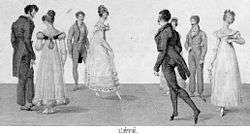Stately quadrille
"Stately quadrille" is a term popularly used to describe the constantly shifting alliances between the Great Powers of Europe during the 18th century. The ultimate objective was to maintain the balance of power in Europe to stop any one alliance or country becoming too strong. It takes its name from the quadrille, a dance in which the participants constantly swap partners.
The most widely cited instance was in 1756, when Britain and Austria abandoned their longstanding Anglo-Austrian Alliance and instead made new alliances with their former enemies, Prussia and France, respectively. That was known as the Diplomatic Revolution.
Background
Shifting alliances had long been a factor in European politics and were often regarded as responses to shifting power and threat. During the 16th century and the early 17th century, much of the emphasis in European politics had been on restricting the power of Spain.
In the second half of the 17th century, Spain was replaced by France as Europe's leading power. Several European coalitions were formed against Spain and France, culminating in the War of the Spanish Succession, from 1702 to 1713.
Quadrille

In the years immediately after the war, Britain and France, which were widely considered to have been the leaders of opposing coalitions in the last war, formed an Anglo-French Alliance and recognised that they shared temporary, mutual interests. In the years that followed, they managed to defeat a resurgent Spain, formerly a French ally, in the War of the Quadruple Alliance. Spain sought an alliance with Austria and gained it in 1725.
By 1731 Britain and France were clearly drifting apart. A diplomatic initiative with Austria was begun by the British government, and a new Anglo-Austrian Alliance was created. Spain withdrew its friendship with Austria and eventually ended up allied to France again.
In 1733, however the Anglo-Austrian Alliance seemed under threat, when the British failed to assist the Austrians in the War of the Polish Succession. Austria had to rely heavily on Russia for assistance and was forced to make huge concessions to France in the 1738 peace treaty. Britain realised that its failure to intervene had allowed France to become too strong.
In 1740, Prussia, an emerging power, attacked Austria. Britain and France soon became embroiled in the war, which ended in a stalemate in 1748, but Austria appeared to have lost most in the war. Despite extensive British funding, it was increasingly disillusioned about the Anglo-Austrian Alliance and began looking for a replacement.
In 1756, Austria did what was considered unthinkable by many by abandoning its British connection to form a new alliance with France. Fearing that Continental Europe would be destabiliand and led to war, Britain made an alliance with Prussia, at the Convention of Westminster in the hope that the new balance of power would prevent war.
Decline
The concept began to fade in the second half of the 18th century, as Britain and France became the dominant European powers. The failure to prevent the Seven Years' War, in which over a million died, was a major factor. States began to seek a more stable and longlasting series of alliances: one of the most successful in the second half of the century was the Bourbon Family Compact between France and Spain, which endured throughout a number of major European conflicts, including the Wars of Austrian and Polish Successions and the Seven Years' War and endured past the American War of Independence in which French and Spanish support contributed towards British defeat.
After the Napoleonic Wars, a Concert of Europe was set up to create a forum for discussion rather than create shifting alliance patterns, which had a tendency to cause major wars.
See also
Further reading
- Clark, Christopher. Iron Kingdom: The Rise and Downfall of Prussia 1600–1947. Penguin Books, 2007
- Simms, Brendan. Three Victories and a Defeat. Penguin Books, 2008.
- Strachan, Hew. The First World War. Simon & Schuster, 2006